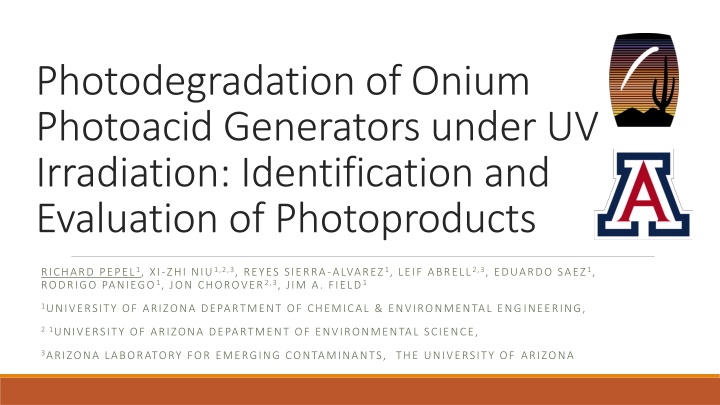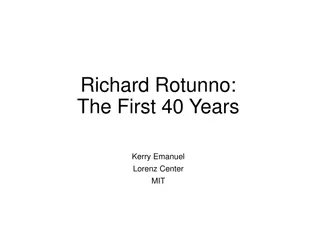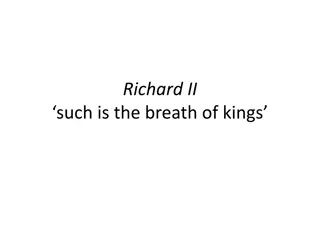
Photodegradation of Onium Photoacid Generators
Explore the photodegradation of onium photoacid generators under UV irradiation, identify photoproducts, and quantify degradation pathways. Learn about the experimental procedures, analytical methods, and quantum yield calculations involved in this study.
Download Presentation

Please find below an Image/Link to download the presentation.
The content on the website is provided AS IS for your information and personal use only. It may not be sold, licensed, or shared on other websites without obtaining consent from the author. If you encounter any issues during the download, it is possible that the publisher has removed the file from their server.
You are allowed to download the files provided on this website for personal or commercial use, subject to the condition that they are used lawfully. All files are the property of their respective owners.
The content on the website is provided AS IS for your information and personal use only. It may not be sold, licensed, or shared on other websites without obtaining consent from the author.
E N D
Presentation Transcript
Photodegradation of Onium Photoacid Generators under UV Irradiation: Identification and Evaluation of Photoproducts RICHARD PEPEL1, XI-ZHI NIU1,2,3, REYES SIERRA-ALVAREZ1, LEIF ABRELL2,3, EDUARDO SAEZ1, RODRIGO PANIEGO1, JON CHOROVER2,3, JIM A. FIELD1 1UNIVERSITY OF ARIZONA DEPARTMENT OF CHEMICAL & ENVIRONMENTAL ENGINEERING, 2 1UNIVERSITY OF ARIZONA DEPARTMENT OF ENVIRONMENTAL SCIENCE, 3ARIZONA LABORATORY FOR EMERGING CONTAMINANTS, THE UNIVERSITY OF ARIZONA
Background Background Onium salts (e.g. triaryl sulfonium, diaryl iodonium salts) are commonly used in semiconductor photolithography as photoacid generators (PAGs) They generate strong acids on UV irradiation, thereby promoting cationic polymerization reactions. However, the kinetics of photodegradation, fate, and the nature of the photodegradation products are poorly understood
Objectives Objectives Identify the characteristics of onium cations of PAGs Develop an analytical method for PAG cations Quantify the photolytic degradation of PAGs at 254 nm Identify the photoproducts of PAGs
Photodegradation PhotodegradationSet Set- -up up
Procedure Procedure Photodegradation experiments were performed under 254 nm UV light Gas Chromatography-Mass Spectrometry (GC-MS) and High Performance Liquid Chromatography with Diode Array Detector (HPLC-DAD) were used to quantify onium concentrations and identify photoproducts
Example of a first Example of a first- -order degradation curve order degradation curve for a PAG cation for a PAG cation 0 The rate constant k is found using the slope of the integrated rate law for a first-order reaction: 0 1 2 3 4 5 -0.5 -1 ln (C/C0) ln[C] = -k t + ln[C]0 -1.5 -2 -2.5 y = -0.7376x R = 0.9923 -3 -3.5 Time (minute)
Quantum Quantum yield yield calculations calculations Quantum yield ( ) is the ratio of converted molecules to photons absorbed. It was calculated using the known quantum yield of para-cresol ???=?? ?????? ???? ?? ?????? ? ?????? ???? ??? quantum yield of PAG, (mole/Einstein); ?? ?????? molar absorptivity of p-cresol, (L mol-1cm-1); ???? molar absorptivity of PAG, (L mol-1cm-1); ???? first order degradation rate constant of PAG under irradiation (s-1); ?? ??????first order degradation rate constant of p-cresol under irradiation (s-1); ? ?????? quantum yield of p-cresol, (mole/Einstein) These values can help predict the amount of cation degraded under any irradiation configurations
PAG photodegradation results PAG photodegradation results Onium cations of the selected PAGs are found to be highly photochemically reactive Onium PAG: 1 2 3 4 1.25 1.23 4.50 3.23 kobs(s-1) 0.38 10-2 0.04 10-2 0.66 10-3 0.05 10-3 t1/2 (s) 51 9 56 2 154 18 214 3 Rapid photodegradation highlights importance of photoproducts 0.62 0.17 0.37 0.01 0.23 0.03 0.85 0.01 (mole/einstein)
Example of Photoproducts of PAG cations Example of Photoproducts of PAG cations as identified by HPLC as identified by HPLC- -DAD and GC DAD and GC- -MS. MS. photoproducts Triphenyl sulfonium
Photodegradation Photodegradation of Onium PAG cations: of Onium PAG cations: Degradation mechanisms Degradation mechanisms Photoproducts
Conclusions Conclusions The model PAGs degrade readily when exposed to UV light at 254 nm. Photodegradation of the model PAGs produces apolar, aromatic products.
Acknowledgements Thank you to the Arizona Space Grant Consortium and to everyone involved in this project: Xi-Zhi Niu1,2,3, Reyes Sierra-Alvarez1, Leif Abrell2,3, Eduardo Saez1, Rodrigo Paniego1, Jon Chorover2,3, Jim A. Field1 1Department of Chemical & Environmental Engineering, 2Department of Environmental Science, 3Arizona Laboratory for Emerging Contaminants, the University of Arizona This was supported in part by the Semiconductor Research Corporation






















